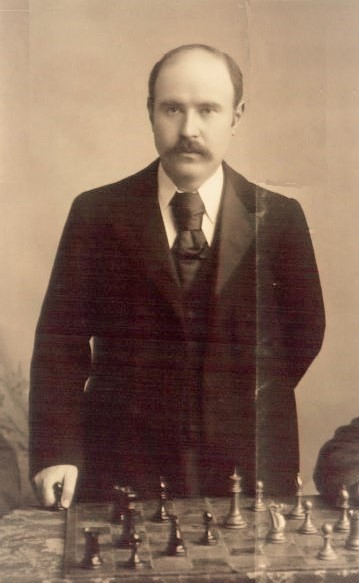
Edward Winter

I.A. Gunsberg (see C.N. 9527)
Isidor Gunsberg was a prolific player and writer whose long career included a match for the world championship. He has been largely forgotten by the chess world, and even contemporary sources shed little light on his character, personality and lifestyle.
(1525)
See page 67 of Chess Explorations, which included his 25-move win against H. von Gottschall, Frankfurt, 22 July 1887.
Chess history is such that it is possible for a master to be narrowly defeated in a world championship match and still be ignored by posterity. Isidor Gunsberg (1854-1930) lost to Steinitz in New York in 1890-91 by a two-game margin. He was also subsequently a prolific columnist, but few nowadays remember what, or even where, he wrote.
When Gunsberg died, Alekhine published a tribute in La Nación of 10 August 1930. He said that the deceased had been ‘a force of the first order between 1885 and 1893’ and that there were two aspects to Gunsberg’s chess individuality; ‘firstly, an absolute lack of originality and, secondly, a clearly exceptional ability to adapt’. Gunsberg showed uncommon skill and ingenuity in ‘understanding the strategic weaknesses of Chigorin’s style and the psychological weaknesses of Steinitz’s style’ and in exploiting these deficiencies during his matches against them. Alekhine continued:
‘For example, to the end of his days Chigorin never knew how to defend as Black against the Queen’s Gambit and believed that the quintessential problem for the second player lay in the satisfactory development of his queen’s bishop. Consequently, in his match against the Russian master, Gunsberg tried all imaginable forms of the Queen’s Gambit and the Queen’s Pawn Game; he thereby obtained, as White, results which were more than satisfactory.
Against Steinitz, who was a renowned connoisseur of the Queen’s Gambit but whose ideas at that time about how to defend against the Evans Gambit were baroque and unhealthy, Gunsberg exploited this factor to combat his great opponent.
... By no means was he a genius, but he was talented and a great worker. Moreover, Gunsberg was highly esteemed for his efforts during a particularly difficult transitional period for our art – to disseminate chess. He therefore has every right to the recognition of all who love chess.’
Scrutiny of the games in the two matches suggests that Alekhine’s thesis about Gunsberg’s opening choices was rather an exaggeration.
(1977)
Concerning the press reports on the 1916 libel case involving Isidor Arthur Gunsberg, we commented in C.N. 360 (written in 1983):
‘All three newspapers mentioned quote the name Arthur, which we have never seen given in reference works.’
Many old sources gave Gunsberg’s initial as J. rather than I. See, for instance, The Book of the Counties’ Chess Association by A.B. Skipworth (London, 1886). The following from page 84 of the February-May 1914 Wiener Schachzeitung may also be noted:
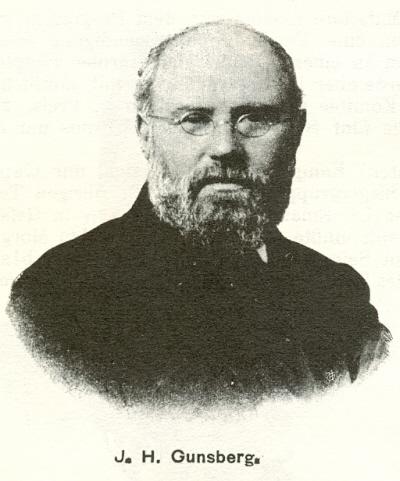
(6798)
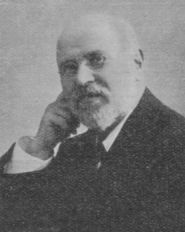
Isidor Gunsberg (BCM, June 1930, page 176)
Among the leading chess masters of the past, one stands out as particularly difficult to grasp in terms of personality and character: Isidor Gunsberg (1854-1930). He is the only world championship challenger on whom no book has been written, and there is even a dearth of ‘human’ articles. Do readers know of any little-known ones which shed light on him?
(5113)
In C.N. 2207 (see page 207 of A Chess Omnibus) we included Gunsberg in a list of many old masters about whom, at that time, no monograph had been written.
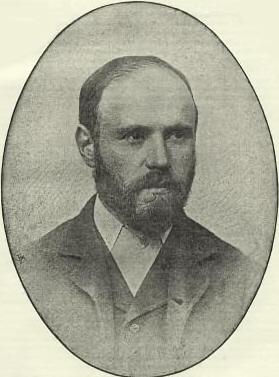
Isidor Gunsberg (Chess
Monthly, September 1888, page 1)
From Elizabeth Tansley (Taunton, England):
‘His obituary in the London Times states that I. Gunsberg was born in Budapest on 2 November 1854 and died on 2 May 1930. [1] It makes no mention of a wife or family, but Gunsberg appears to have married three times – to Jane, Miriam and Agnes.
Jane [2] died, aged 38, at Wandsworth in 1891, shortly after the census. She was listed as Isidor’s wife in the 1881 census, and it seems likely that their marriage took place in London in 1879 [3], where his name is spelt Isidore Gunzberg in the index. Jane is probably Jane Isaacs. Three of their surviving children are in the 1891 census: Alfred (1884) [4], Herbert (1886) [5] and Lionel (1887) [6].
Isidor remarried as Isidor Arthur Gunsberg in 1893 [7] at St Giles, London to Miriam Clarke. She died [8], aged 39, in 1897 at Barnet, having given birth to two daughters, Grace Winifred (1894) [9] and Miriam (1896) [10], both of whom are in the 1901 census.
Having now five children to look after, he remarried [11] in 1898 at Lambeth to Agnes Ramage, recorded as Agnes Jane in the 1901 census. They had a daughter, Kathleen Ramage Gunsberg [12], in the 1901 census, aged two months. Isidor was now 46 years old and Agnes 38.
He became a naturalized British subject [13], under the name of Isidor Arthur Gunsberg of 14 Honeybrook Road, Balham, taking the Oath of Allegiance on 12 May 1908 [14].
On 13 December 1916 Gunsberg was successful in suing Associated Newspapers and the Chess News Agency for libel, winning £250 in damages. The report of the action in The Times [15] contains some interesting facts, namely that his father was a Russian Pole and that Gunsberg had been brought to England in 1862, aged eight. At the time of the trial he had been chess editor of the Daily Telegraph for 26 years.
On 20 July 1923 [16], giving his address as 14a Lunam Road, Upper Norwood SE19, he filed for bankruptcy at the High Court. The bankruptcy was not finally discharged until 17 April 1930 [17] in the month before his death.
Sources:
(5129)
Concerning the above reference to the Daily Telegraph, Gunsberg’s post as the chess correspondent of that newspaper was mentioned in the first sentence of the BCM’s obituary of him (June 1930 issue, page 176). See too our feature article on G.H.D. Diggle, which referred to Gunsberg in connection with Nigel Short, another challenger for the world chess championship and, also, a chess columnist of the Daily Telegraph. In an article reproduced in C.N. 6538, G.H. Diggle mentioned seeing Gunsberg at Scarborough, 1928.
As noted in C.N. 1526, page 253 of the June 1895 BCM mentioned a new chess column in the Lady’s Pictorial, ‘edited by Mrs Gunsberg’. Moreover, page 26 of the January 1903 BCM had a reference to a solving tournament won by ‘a young son of Mr Gunsberg’. See C.N. 3751, as well as the reference on page 185 of Chess Explorations (C.N. 702).
Further information on these family members is still being sought, and we add here the following (unsigned) passage from page 128 of the April 1890 BCM:
‘Mr Gunsberg has had a severe domestic affliction since his return from Havana, as he has lost a child. He tells me that he has no doubt that his match with Steinitz will take place in the autumn.’
(4098)
Extensive biographical information about Gunsberg and his family was subsequently presented in Eminent Victorian Chess Players by T. Harding (Jefferson, 2012)
Joost van Winsen (Silvolde, the Netherlands) submits an interview with Gunsberg which was published in the Bradford Observer Budget of 28 July 1888. The copy currently available is imperfect, and a couple of the dates in the extensive extracts below are marked as uncertain:
‘A Chess Champion Interviewed
Mr I. Gunsberg, who is one of the greatest of living chessplayers, was in Bradford a few days ago, and ... one of our representatives waited upon him, and obtained in conversation the following interesting particulars of his life’s history. Mr Gunsberg is a native of Hungary, and only 33 years of age. When a mere boy of 11 his father taught him the elements of chess, that being at a time when the Hungarian Chess School was represented by such players as Fähndrich, Englisch, Kolisch and Dr Noa. Shortly afterwards young Gunsberg went to live in Paris, where at the Café de la Régence – a renowned chess resort – he encountered the strongest players in the capital. He, of course, received great odds from the recognized masters, such as Rosenthal, Steinitz and Kolisch, but against amateurs he was already able to hold his own, though at this time under 12 years of age. Four years later he was considered “a pawn and two moves” player; that is to say, he received the odds of pawn and two moves from the masters. In 1867 he returned to Pesth, his native town, and proved himself to be as good a chessplayer as any of the Hungarians, Schwarz, Englisch and Fähndrich excepted.
The year 1876 [?] found Gunsberg in England, a frequenter of the London chess resorts, and a formidable antagonist. ... Then he disappeared from the chess resorts with unaccountable suddenness, and little was seen of him for upwards of three years. [There followed a brief account of Gunsberg’s involvement with Mephisto.]
The mysterious element in Gunsberg’s doings having ultimately been demolished, Gunsberg reappeared in the public arena. Very shortly after he resumed public play he challenged so redoubtable an opponent as Blackburne to a match, and a contest was arranged in which the Englishman conceded the odds of two games, and won by a single game. The same year Gunsberg won the second prize in the City of London Handicap, and three years later he gained the first honours in the same annual competition. At this time – in 1884 [?] – it was beginning to be recognized that Gunsberg was no mere second-rate master. [The newspaper item then discussed Gunsberg’s relations with Bradford and other events in which he had participated.]
Questioned as to his relations with Steinitz, Mr Gunsberg said he had played one game against Steinitz when the latter was giving a simultaneous performance in 1877, and that he (Gunsberg) lost. He added that he considered Mr Steinitz undoubtedly the strongest living exponent of the game. He should very much like to play him a match, but not until his play got a little more mature. Gunsberg frankly admits that his weakness as a chessplayer is impetuosity in attack, and he observed that when he did undertake to play the champion he should stand a good chance, the natural inference from that statement being that he means to prepare himself for the encounter. Steinitz is not exactly notorious for friendliness of feeling toward other noted chessplayers. Regarding this point Gunsberg says he met Steinitz frequently for years, and was on friendly terms with him, but he doubts whether the champion would still feel inclined to be very amiable to him, though his own feelings towards him are unaltered.
The conversation turned at length upon the forthcoming International Congress at Bradford. Judging from the great variety of events, he thinks this congress will be the finest provincial chess meeting ever held. Up to the present time, he said, only Germany has been able to arrange successful provincial gatherings of so extensive a kind. In no other country have chessplayers ever succeeded in having a meeting of such importance outside the capital. He declined to prophesy as to the probable winner of the Masters’ Tournament, but has sufficient confidence in himself to express the opinion that his chances are as good as those of anybody else. He is in very fair form at present, but, as everybody knows, is very liable to sudden physical depression.
Speaking generally of the uses and effects of chessplaying, Gunsberg said that, if practised in season and in proper measure, it was the best of all pastimes, even for men whose profession greatly exercised the mind, always provided that they did not neglect physical exercise. In fact, he continued, it seems that those engaged in hard brain work require additional brain work as a recreation, just as those engaged in hard physical labour chiefly require manual exercise in their pastimes. All that is necessary to constitute either mental or physical recreation are change and interest. To attain perfection as a chessplayer, Mr Gunsberg said a man must have a combination of the qualities of physical vigour, strong imagination, logical mind, patience, perseverance, industry and mind force, all of which the game of chess developed to some extent. He believed that in the degree in which any of those qualities are undeveloped or lacking the play is weakened. Book knowledge he regards as not absolutely necessary to success, for, whilst on the one hand it gives the player the benefit of the accumulated experience of the best students of the present and past age, on the other hand want of it leads to more self-reliance and independence of thought. Almost the same argument answers to the necessity of a good memory. Mr Gunsberg admitted that he possessed neither of these qualities. The possession of either or both of them would greatly strengthen his play, but would also alter the style of it considerably ...’
The following month Gunsberg won the Bradford tournament, ahead of Mackenzie, von Bardeleben, Mason, Burn, Blackburne and Weiss.
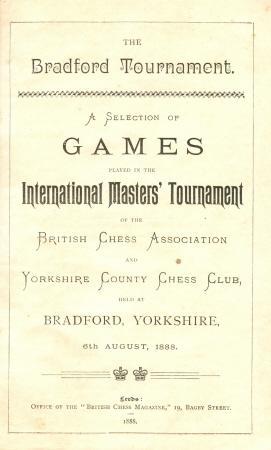
(5136)
Pages 171-172 of the 30 July 1893 issue of Emanuel Lasker’s magazine the London Chess Fortnightly quoted some remarks about Gunsberg by Steinitz in the New York Tribune. The context was a dispute over whether Lasker had a right to issue a world championship challenge to Steinitz, and we give merely the start of the latter’s salvo (which Lasker quoted approvingly):
‘Mr Gunsberg is not alone a chess professor, but he also professes to be a philosopher of the so-called “individualistic school”, and he has lectured and written on doctrines which, if I may quote myself, are based on the theory that “one man has rights, but two men have none”. When, however, he applies his egoistic principles to chess affairs, he finds that though he may be unique in the chess world he is not alone in it. For instance, he seems to be possessed of the idea that the championship of the world can only be at stake when he himself is a party in a contest. Thus he played a match with Chigorin for “the championship of the world”, and the whole chess world laughed. He fought another for the title against myself in which he virtually received the odds of the draw and played to take advantage of the odds. The whole chess world might have laughed if – he had won it ...’
We are still seeking information about the meeting between Gunsberg and Capablanca depicted in the photograph below from page 497 of The Strand Magazine, May 1914 (C.N. 3785):
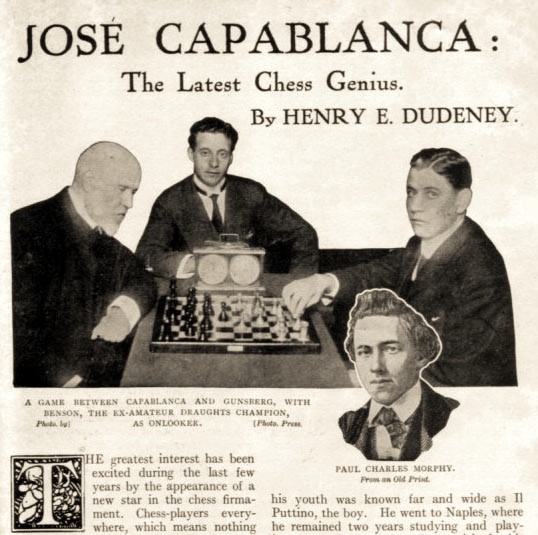
A further question is why Gunsberg’s forename was, during his lifetime, so often given as J., rather than I. To quote just one late example, the Marienbad, 1925 tournament referred to ‘J. Gunsberg’.
On the other hand, the initial I. was, fortunately, used in the acrostic poem by W. Williams published on page 275 of the Chess Player’s Chronicle, 29 November 1890:
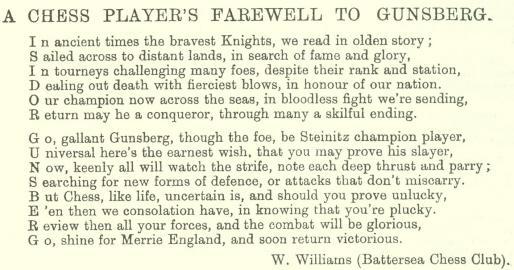
(5137)
Relatively early pictures of Isidor Gunsberg are uncommon, and we were glad to find the one below in Hans von Minckwitz’s column on page 21 of the Illustrirte Zeitung, 5 July 1890:
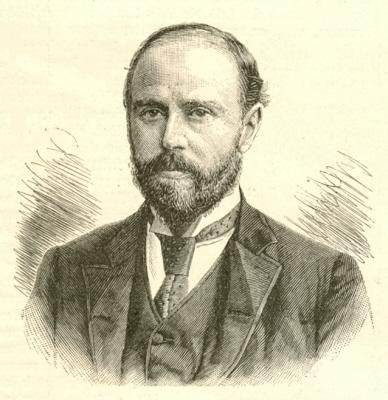
(5154)
This portrait of Gunsberg was published opposite page 90 of the Hastings, 1895 tournament book edited by Horace F. Cheshire:

Joost van Winsen offers details regarding Gunsberg [as well as Blackburne, Hoffer and Steinitz] from the records in British censuses ...
1881 census: Isidor Gunsberg. Age: 26. Born in Budapest, Hungary. Address: 287 Mile End Road (Hamlet), London. Occupation: Tobacconist and professional chessplayer. Married to Jane Gunsberg (age 28).
1891 census: Isador [sic] Gunsberg. Age: 36. Born in Hungary. Address: 22 C ... [illegible] Road, Battersea, London. Occupation: Chessplayer and journalist. Married to Jane Gunsberg (age 38). Children: Alfred Gunsberg (son, age 6), Bertie Gunsberg (son, age 5), Lionel Gunsberg (son, age 3). One servant was a member of the household: Alice Jennings (age 21).
1901 census: Isidor Arthur Gunsberg. Age: 46. Born in Hungary. Address: 113 Clifford Road, Monken Hadley. Occupation: Author, journalist. Married to Agnes Jane Gunsberg (age 38). Children: Alfred Tudor Gunsberg (son, age 17), Kathleen Ramage Gunsberg (daughter, age 2 months), Miriam Gunsberg (daughter, age 4), Winifred Grace Gunsberg (daughter, age 6). One servant (Elizabeth Hatfield, age 56) and one relative (Winifred Ramage, age 27) were members of the household.
(4756)
From page 2 of the 9 March 1895 edition of the Newcastle Courant:
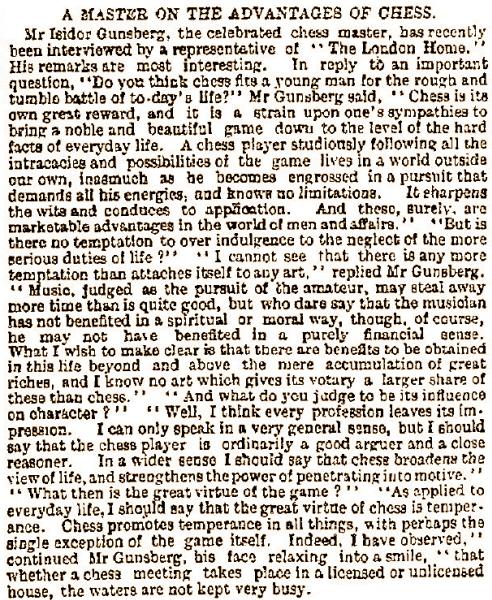
A remark of Gunsberg’s which is worth highlighting:
‘... there are benefits to be obtained in this life beyond and above the mere accumulation of great riches, and I know no art which gives its votary a larger share of these than chess.’
(8324)
Gunsberg may also be the only person to write a premature obituary of a player against whom he contested a world title match. Below is a sequence of items in the Pall Mall Gazette, of which Gunsberg was the chess editor:

12 February 1897, page 9
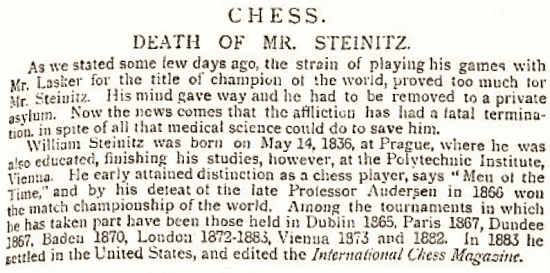
22 February 1897, page 9

24 February 1897, page 9
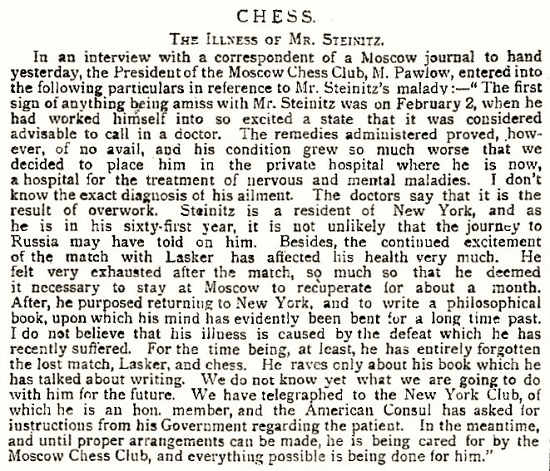
26 February 1897, page 10
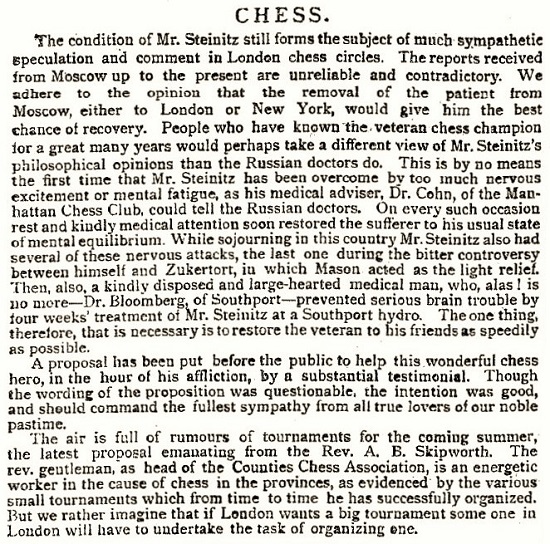
8 March 1897, page 10
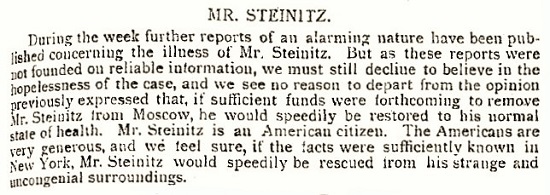
15 March 1897, page 9
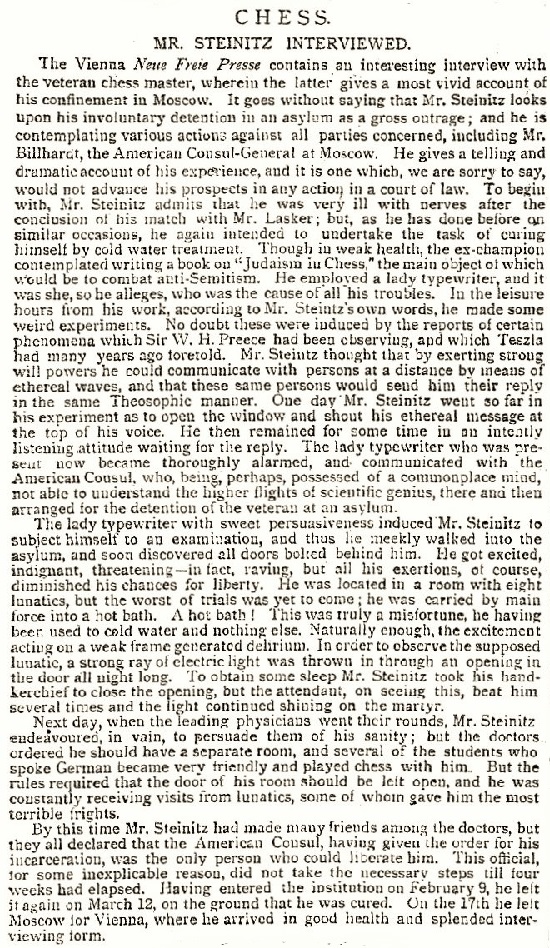
5 April 1897, page 10.
(9830)
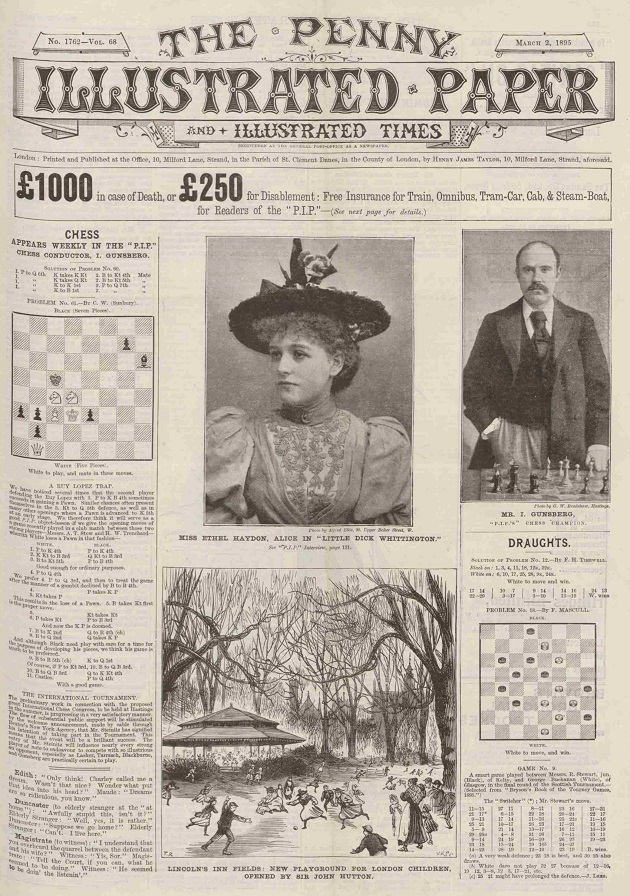
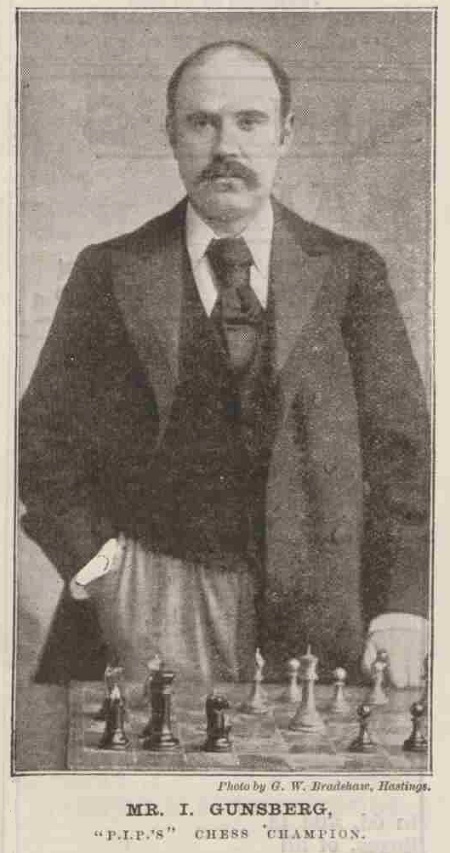
(11248)
Tony Gillam (Nottingham, England) writes:
‘There is an interesting point about Monte Carlo, 1901. It is not clear what Gunsberg’s last game result was. Some contemporary tables give a loss and some a draw. Some newspaper reports say he lost by default, and others say the game was agreed drawn (in fact; as draws had to be replayed, this means that the players agreed to halve the point and didn’t play). It has to be remembered that players had to pay their own accommodation expenses and so, if out of the prize hunt, would agree to halve the point. Four last-round games at Monte Carlo, 1902 were “decided” this way. The only way to get an authentic result for the Gunsberg game is to search de Rivière's columns in Paris papers. As he was the arbiter, his version is presumably correct.’
(1558)
Isidor Gunsberg is the only world championship challenger who has not yet been the subject of a games collection. Any anthologist who cares to repair this injustice will be able to use raw material such as the following:
Knapton – Isidor Arthur Gunsberg
Bradford, 1885 (?) [See C.N. 4825 below.]
Two Knights’ Defence
1 e4 e5 2 Nf3 Nc6 3 Bc4 Nf6 4 Ng5 d5 5 exd5 Na5 6 Bb5+ c6 7 dxc6 bxc6 8 Be2 h6 9 Nf3 e4 10 Ne5 Qd4 11 Ng4 Nxg4 12 Bxg4 e3 13 Bf3 exf2+ 14 Kf1 Ba6+ 15 d3 O-O-O 16 Qe2 Bc5 17 Nd2 Rhe8 18 Be4

18...Nc4 19 Nb3 Qxe4 20 dxe4 Rd1+ 21 Qxd1
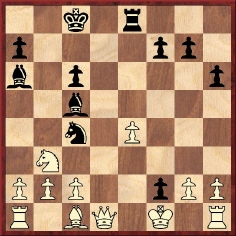
21...Nd2 mate.
Source: Brooklyn Chess Chronicle, 15 April 1885, page 108.
Isidor Arthur Gunsberg – Vitta
Nice, 1925
Caro-Kann Defence
1 e4 c6 2 d4 d5 3 Nc3 dxe4 4 Nxe4 Nf6 5 Ng3 e5 6 Nf3 exd4 7 Nxd4 Bc5 8 Be3 Ng4 9 Qd2 Nxe3 10 fxe3 Be7 11 Bc4 c5 12 O-O Be6

13 Nxe6 Qxd2 14 Nxg7+ Kd8 15 Rad1 Qd7 16 Bxf7 Bd6 17 Ne4 Rf8 18 Nxd6 Qg4 19 Ne6+ Ke7 20 Nxf8 Nc6 21 Be6 Black resigns.
Source: BCM, January 1926, page 29.
(2082)
Regarding the above Knapton v Gunsberg game, Marc Hébert (Charny, Canada) reports that page 4 of the (Quebec) Morning Chronicle, 8 January 1885 gave the game-score with the heading ‘Played at the Exchange Café, Market Street, Bradford ... Notes by Mr I. Gunsberg, from the Bradford Observer’. This indicates that the game was played no later than 1884, and we shall be grateful if a reader can trace the original publication in the Bradford newspaper.
(4825)

White to move
In this game (W. M. Gattie v Isidor Arthur Gunsberg, London, 17 September 1887) White played 1 Re5, prompting Black to leave his queen en prise in order to construct a mating net. However, after 1…h5, White’s response 2 Qa6+ caused Black to resign. Gunsberg subsequently pointed out that he should have played 1…Nh5+ 2 Kg2 Bh3+ 3 Kxh3 (If 3 Kg1 then 3…Qxf3 wins.) 3…Qxf3+ 4 Bg3 Nf4 mate.
Source: Chess Monthly, October 1887, page 58.
(2532)
C.N. 5696 quoted some pen-portraits concerning New York, 1889, from page 5 of the New York Times, 26 March 1889. Below is the paragraph concerning Gunsberg (and Burn):
‘Both Gunsberg and Burn are Englishmen, and are said to be well matched. Gunsberg is a blonde, with very deliberate movements and a habit of looking out of the corner of his eye at his opponent when he moves a piece, as though he expected to trip him up. Burn pulls his hat over his eyes with a “you-can’t-catch-me” expression as he deliberates, and not unfrequently changes an attack into a defense. Gunsberg sips seltzer, and Burn puffs away at a cigar.’
Stephen Davies (Kallista, Australia) reports that further pen-portraits of the participants in New York, 1889 were published on page 8 of the New York Times, 16 June 1889, under the heading ‘The Chessboard Kings’, with the subtitle ‘Ways and looks of 20 great players’. The extracts transcribed below (which often go awry with the players’ ages) focus on physical descriptions. On Gunsberg:
‘... Isidor Gunsberg was brought up in London, and has the appearance of an Englishman. His hair is very light, and he is slightly bald on the top of his head. A little below the medium height, he is not slender. His eyes are weak and trouble him a little. In his movements and conversation he is deliberate, his chess training having probably disciplined him to be guarded in everything he undertakes. Unlike the other players, he neither smokes nor drinks, because both vices disagree with him. The only beverages he indulges in besides water are vichy and tea. ... If he refuses the offer of a draw he does so without any bluster, for he is modest and gentlemanly. When he wins, he nods, and smiles at his defeated antagonist.’
(5710)
Heppell – Isidor Arthur Gunsberg
London, 1883
(Remove Black’s f-pawn.)
1 e4 Nc6 2 d4 d5 3 e5 Bf5 4 Nf3 e6 5 a3 Nge7 6 Nh4 Be4 7 Bg5 h6 8 Be3 g5 9 Nf3 Nf5 10 c3 g4 11 Nfd2 Nxe3 12 fxe3 Bf5 13 g3 Qg5 14 Qe2 h5 15 Bg2 O-O-O 16 Nf1 Qg6 17 e4 dxe4 18 Nbd2
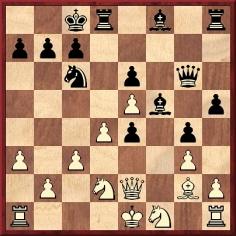
18...e3 19 Nxe3 Bd3 20 Qf2 Bh6 21 Bxc6 bxc6 22 Ng2 Rhf8 23 Nf4 Rxf4 24 gxf4 Rf8 25 Rf1 Rxf4 26 Qxf4 Bxf4 27 Rxf4 Qh6 28 Rf1 Qe3+ 29 Kd1 Be2+ 30 Kc2 Qd3+ 31 White resigns.
Source: Knowledge, 16 November 1883, pages 311-312.
Gunsberg wrote the chess column in Knowledge under the pseudonym ‘Mephisto’. He reported that the game had been played in a handicap tournament at Purssell’s Chess Room and lasted two hours 40 minutes.
(6039)
Three years before playing Steinitz for the world championship, Gunsberg lost a match-game in 11 moves:
Joseph Henry Blackburne – Isidor Arthur Gunsberg1 e4 e5 2 Nf3 Nc6 3 Bb5 Nf6 4 Qe2 a6 5 Ba4 Bc5 6 c3 b5 7 Bc2 d5 8 exd5 Qxd5 9 d4 Bd6 10 Bb3 Qe4 11 Qxe4 Resigns.
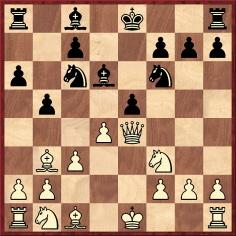
Sources: BCM, November 1887, pages 429-430 (which included the players’ brief notes) and Chess Monthly, December 1887, pages 112-113.
There are databases which have the move order as 3...a6 4 Ba4 Nf6 5 Qe2 Bc5 and, even, are wrong about the occasion of the game (e.g. giving the date as 1890).
(6508)
Further to the material in Chessplayer Shot Dead in Hastings, another consultation game involving F.W. Womersley and Janowsky, against Gunsberg and Locock, was published on page 9 of the Pall Mall Gazette of 29 January 1898 (chess column by Gunsberg) and on pages 112-114 of the March 1898 BCM (annotations by Janowsky):
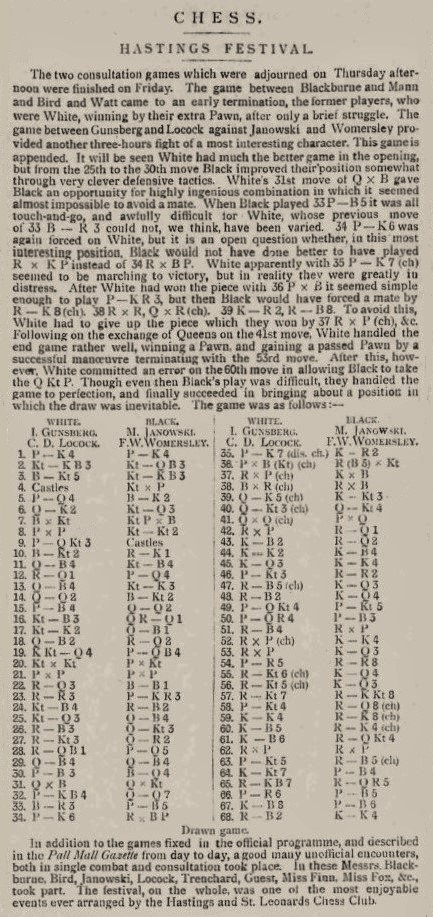
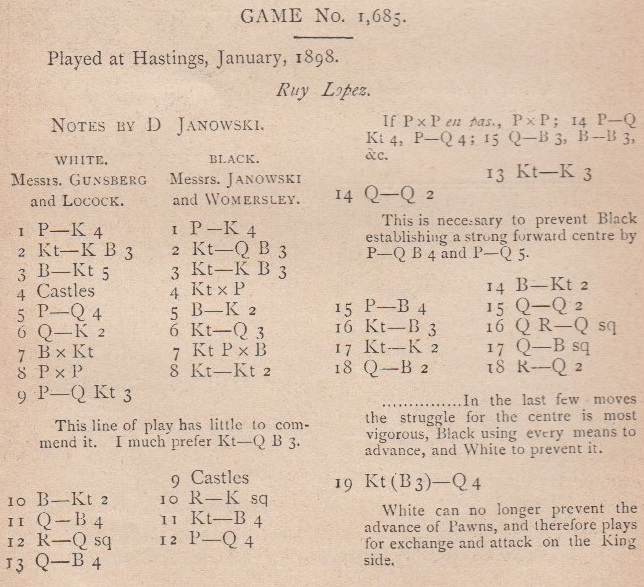
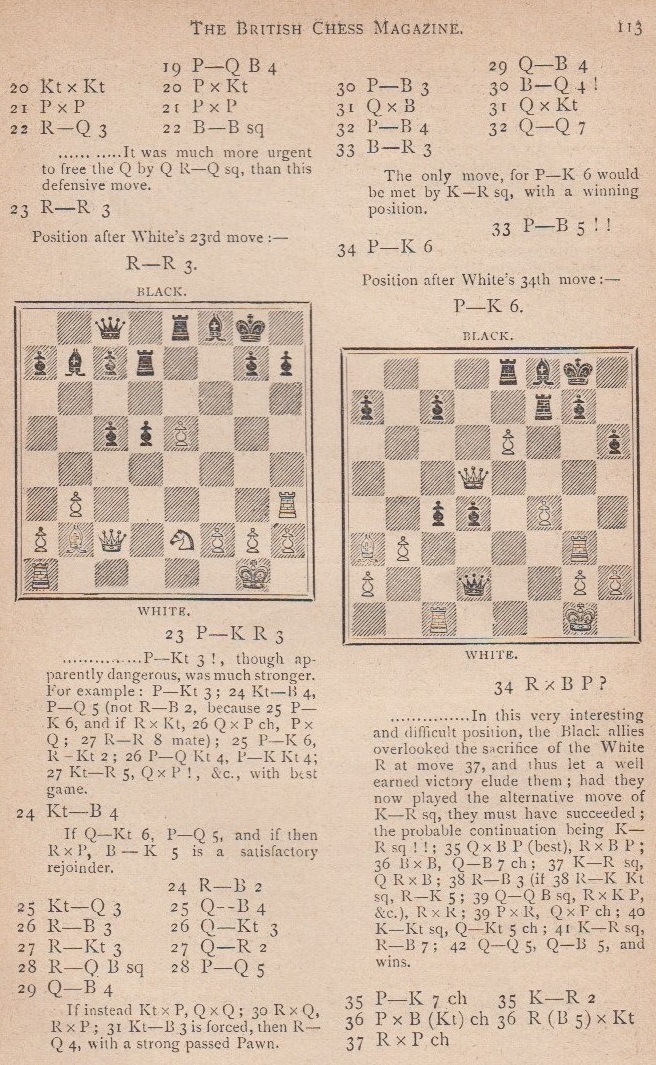
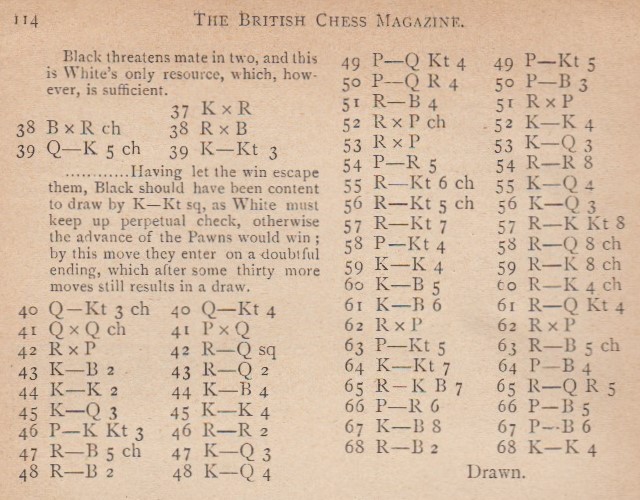
1 e4 e5 2 Nf3 Nc6 3 Bb5 Nf6 4 O-O Nxe4 5 d4 Be7 6 Qe2 Nd6 7 Bxc6 bxc6 8 dxe5 Nb7 9 b3 O-O 10 Bb2 Re8 11 Qc4 Nc5 12 Rd1 d5 13 Qf4 Ne6 14 Qd2 Bb7 15 c4 Qd7 16 Nc3 Rad8 17 Ne2 Qc8 18 Qc2 Rd7 19 Nfd4 c5 20 Nxe6 fxe6 21 cxd5 exd5 22 Rd3 Bf8 23 Rh3 h6 24 Nf4 Rf7 25 Nd3 Qf5 26 Rf3 Qg6 27 Rg3 Qh7 28 Rc1 d4 29 Qc4 Qf5 30 f3 Bd5 31 Qxd5 Qxd3 32 f4 Qd2 33 Ba3
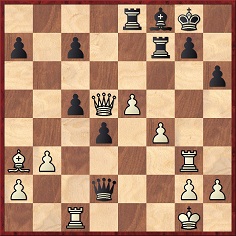
33...c4 34 e6 Rxf4 35 e7+ Kh7 36 exf8(N)+ Rfxf8 37 Rxg7+ Kxg7 38 Bxf8+ Rxf8 39 Qe5+ Kg6 40 Qg3+ Qg5 41 Qxg5+ hxg5 42 Rxc4
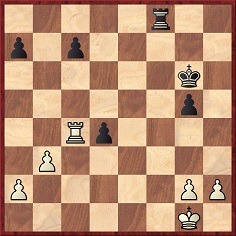
42...Rd8 43 Kf2 Rd7 44 Ke2 Kf5 45 Kd3 Ke5 46 g3 Rh7 47 Rc5+ Kd6 48 Rc2 Kd5 49 b4 g4 50 a4 c6 51 Rc4 Rxh2 52 Rxd4+ Ke5 53 Rxg4 Kd6 54 a5 Rh1 55 Rg6+ Kd5 56 Rg5+ Kd6 57 Rg7 Rg1 58 g4 Rd1+ 59 Ke4 Re1+ 60 Kf5 Re5+ 61 Kf6 Rb5 62 Rxa7 Rxb4 63 g5 Rf4+ 64 Kg7 c5 65 Rf7 Ra4 66 a6 c4 67 Kf8 c3 68 Rf2 Ke5 Drawn.
The game was played in Hastings on 27-28 January 1898.(9657)
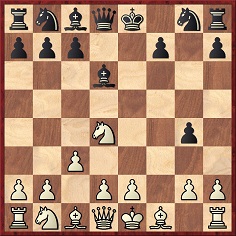
Black to play
It seems extremely unlikely that Black, a former world championship challenger, missed an immediate, elementary win with 6...Qh4+, but that was the claim on page 104 of Adventure in Chess by Assiac (London, 1951):
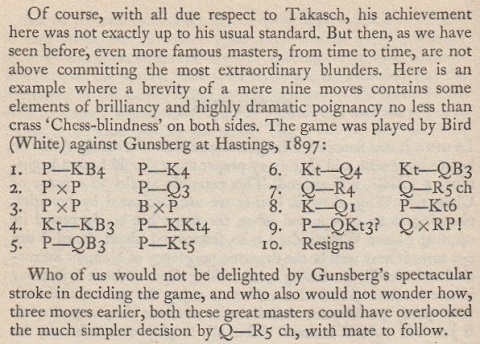
As will be seen below, the move order given by Assiac was wrong; the white queen went to a4 on move six, not seven.
The next problem with Assiac’s account is that he mentioned only Bird and Gunsberg, whereas it was a consultation game, and one of the most famous. From page 18 of Chess Review, October 1933, in an article entitled ‘Curious Chess Facts’ by Irving Chernev:
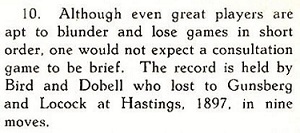
The same text was on page 47 of Chernev’s book Curious Chess Facts (New York, 1937), and he presented an expanded version on page 52 of Wonders and Curiosities of Chess (New York, 1974):
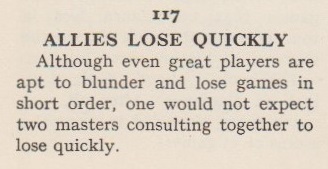
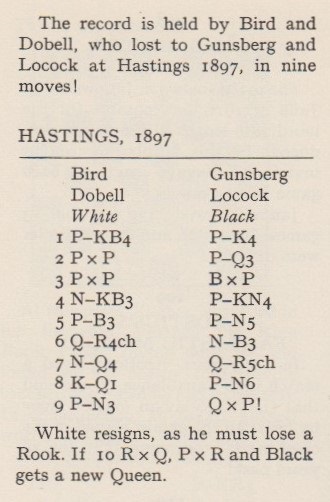
Chernev also gave it on page 15 of 1000 Best Short Games of Chess (New York, 1955). The score had been published too on page 276 of 200 Miniature Games of Chess by Julius du Mont (London, 1941) and was referred to as ‘the famous nine-mover’ on page 120 of the same author’s Chess More Miniature Games (London, 1953). See also page 12 of 666 Kurzpartien by Kurt Richter (Berlin-Frohnau, 1966). The game’s status as the shortest consultation game ever played had already been proclaimed in 1897, as shown by page 148 of the May Deutsche Schachzeitung:
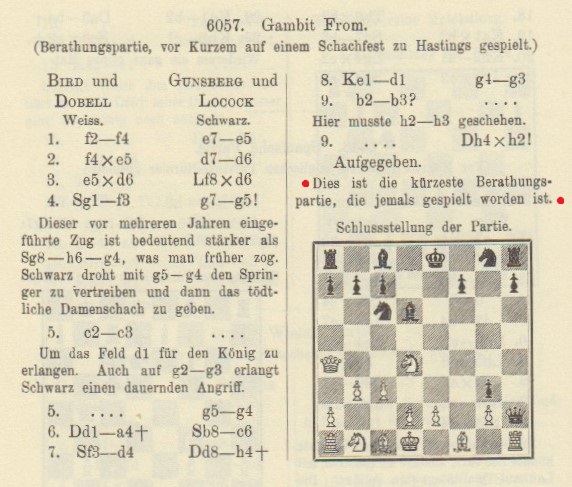
The game was dated 1896 on page 883 of the Handbuch des Schachspiels (Berlin and Leipzig, 1922), whereas 1892 was given on page 649 of 500 Master Games of Chess by S. Tartakower and J. du Mont (London, 1952). In reality, it was played in the Hastings Chess Festival on 15 February 1897. The BCM did not publish the score but offered a description on page 90 of its March 1897 issue which shows that it was not a nine-mover at all:
‘The attraction of Monday afternoon was a consultation game, Messrs Bird and Dobell against Messrs Gunsberg and Locock. White adopted Bird’s favourite P-KB4, which Black turned into a From Gambit. The game caused much amusement to the company, as so early as the ninth move the White allies were in difficulties, owing to a peculiar oversight threatening the loss of a rook, and might have resigned after the 18th move, although the game was continued for several more moves before White resigned.’
Subsequent writers overlooked that report and the fact that the game was published by Gunsberg in his column in the Pall Mall Gazette, 22 February 1897, page 9:
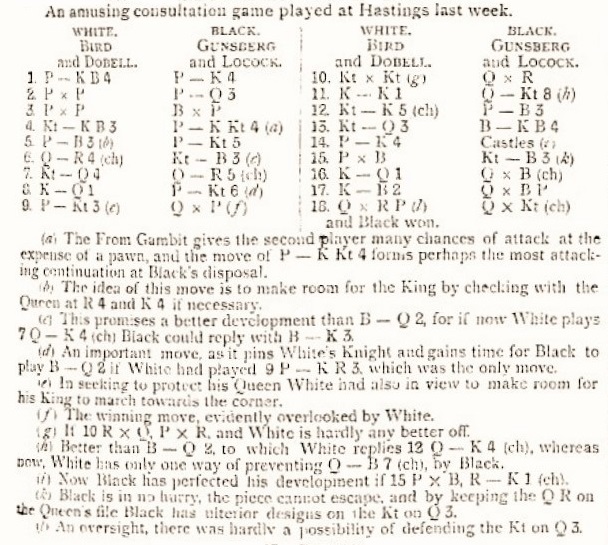
1 f4 e5 2 fxe5 d6 3 exd6 Bxd6 4 Nf3 g5 5 c3 g4 6 Qa4+ Nc6 7 Nd4 Qh4+ 8 Kd1 g3 9 b3 Qxh2 10 Nxc6 Qxh1 11 Ke1 Qg1 12 Ne5+ c6 13 Nd3 Bf5 14 e4 O-O-O 15 exf5 Nf6 16 Kd1 Qxf1+ 17 Kc2 Qxf5 18 Qxa7
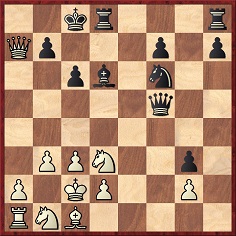
18...Qxd3+ and Black won.
(9670)
From page 2 of the Morning Post, 6 April 1886:
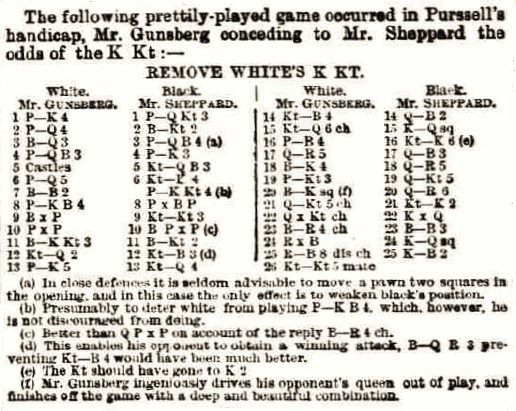
(Remove White’s king’s knight.) 1 e4 b6 2 d4 Bb7 3 Bd3 c5 4 c3 e6 5 O-O Nc6 6 d5 Ne5 7 Bc2 g5 8 f4 gxf4 9 Bxf4 Ng6 10 dxe6 fxe6 11 Bg3 Bg7 12 Nd2 Nf6 13 e5 Nd5 14 Nc4 Qc7 15 Nd6+ Kd8 16 c4 Ne3 17 Qh5 Qc6 18 Be4 Qa4 19 b3 Qb4 20 Be1 Qa3 21 Qg5+ Ne7
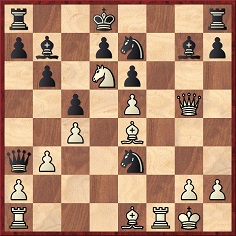
22 Qxe7+ Kxe7 23 Bh4+ Bf6 24 Rxf6 Kd8 25 Rf8+ Kc7 26 Nb5 mate.
The newspaper’s notes were reproduced on pages 463-464 of the Chess Player’s Chronicle, 7 April 1886, and a news report on page 457 of the same issue of the magazine stated:
‘A handicap tournament which has been in progress for some time past at Purssell’s restaurant, EC, has resulted in favour of Mr Gunsberg. Mr Fenton, who received the odds of pawn and two moves from the winner, was second.’
(9840)
A Reinfeld book with two of his longest sets of annotations is A Chess Primer (New York, 1963):
In each case, Reinfeld reworked notes that he had contributed to the Chess Correspondent (respectively, May-June 1945, pages 6-7 and 20, and March-April 1945, pages 4-5) ...
Reinfeld’s book was re-issued by Stein and Day, New York in 1977 with a nine-page introduction by A. Soltis. The following year that edition appeared under the title Chess Basics (Key Book Publishing Company, Toronto).
(9915)
A game included in a contribution by Hans Renette (Bierbeek, Belgium) concerning H.A. Reeves (C.N. 10065):
Henry Albert Reeves – Isidor
Arthur Gunsberg
London (Masters’ Tournament, British Chess Club), 1886
Ruy López
1 e4 e5 2 Nf3 Nc6 3 Bb5 a6 4 Ba4 Nf6 5 O-O Nxe4 6 d4 b5 7 Bb3 d5 8 dxe5 Be6 9 Bf4 Ne7 10 c3 Ng6 11 Bg3 Bc5 12 Kh1 h5 13 h4 Be7 14 Bc2 Bg4 15 Qe1 Nc5 16 Nbd2 Bxf3 17 Nxf3 Nxh4 18 Nd4 Ne6
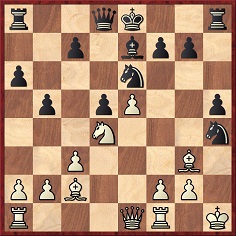
19 f4 Nxd4 20 cxd4 g6 21 e6 Rh6 22 f5 g5 23 Qe3 Bf8 24 Rae1 fxe6 25 fxe6 Rf6 26 Qd3 Qe7 27 Rxf6 Qxf6 28 Bxh4 gxh4 29 Qh7 resigns.
Source: The Field, 3 April 1886, page 412.
(10065)
From page 2 of the 27 October 1894 edition of the Nottinghamshire Guardian:
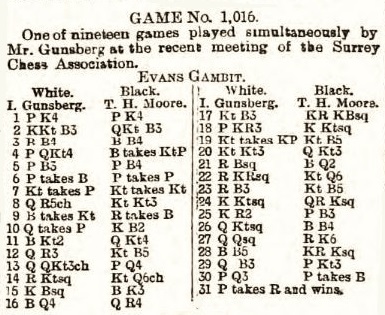
1 e4 e5 2 Nf3 Nc6 3 Bc4 Bc5 4 b4 Bxb4 5 c3
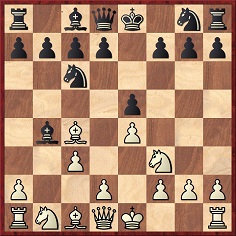
5...f5 6 cxb4 fxe4 7 Nxe5 Nxe5 8 Qh5+ Ng6 9 Bxg8 Rxg8 10 Qxh7 Kf7 11 Bb2 Qg5 12 Qh3 Nf4 13 Qb3+ d5 14 Rg1 Nd3+ 15 Kf1 Be6 16 Bd4 Qh5 17 Nc3 Rgf8 18 h3 Kg8 19 Nxe4 Nf4 20 Ng3 Qg6 21 Rc1 Bd7 22 Rh1 Nd3 23 Rc3 Nf4 24 Kg1 Rae8 25 Kh2 c6 26 Qb1 Bf5 27 Qd1 Re4
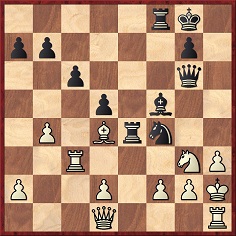
28 Bc5 Rfe8 29 Qf3 b6 30 d3 bxc5 31 dxe4 and wins.
The display took place in London on 6 October 1894 (BCM, November 1894, page 462).
As mentioned in The Evans Gambit, there was an article about 5...f5 on pages 373-374 of the November 1915 BCM. The move was played by Blackburne against ‘C. and W.’ in Hastings in 1894 (page 180 of P. Anderson Graham’s work on Blackburne) and, as mentioned in that book, was analysed by Oskar Cordel. See page 76 of his treatise Führer durch die Schachtheorie (Berlin, 1888), as well as a feature on pages 56-58 of Brüderschaft, 18 February 1888.
(10852)
On pages 210-211 of The Adventure of Chess (New York, 1959) Edward Lasker relates how, in London in 1912, Gunsberg played a trick on him when getting him to play a game against a woman visitor to the Divan. Only after Lasker had lost did Gunsberg tell him that she was Mrs Fagan, who ‘just recently returned from San Remo, where she won the ladies’ world championship’. The story is also related on page 171 of Bradley Ewart’s Chess: Man vs Machine.
A few contemporary sources, such as page 37 of the second volume of Schachjahrbuch für 1911, refer to a ladies’ tournament in San Remo in 1911, but none mentions the title ‘world championship’ or gives Mrs Fagan as a competitor. They all say that the event was won by Miss Kate Finn of London.
Did Lasker mix up the names Finn and Fagan? And what was the basis for the ‘world championship’ claim?
(2120)
‘In the success of Tarrasch, Steinitz’s method of play has achieved its greatest triumph. But the scholar is acting more faithfully on the precepts of the teacher than the master himself, who will often forget his own teachings and adhere to crotchety lines of play in the openings, a thing which Tarrasch never does.’
Gunsberg, in the Evening News, quoted on page 410 of the October 1890 BCM.
Kings, Commoners and Knaves, page 387
‘To play solely to win a game which offers such inviting temptations to anyone gifted with an imagination, requires a man who has fishblood in his veins.’
Isidor Gunsberg, in an article he contributed on pages 74-77 of Chess Pie, 1922.
(3084)
At the Wijk aan Zee, 2000 tournament Kasparov showed aggressive displeasure at the attribution of game prizes, and his behaviour is worth contrasting with Carl Schlechter’s.
From page 19 of The Year-Book of Chess, 1907 here are Gunsberg’s words concerning the Ostend, 1906 tournament:
‘… Schlechter was the one competitor who accepted all things and all arrangements with equanimity amounting almost to indifference. Everything was right for him and nothing amiss, and this man, who apparently paid such little regard to his interests, was the winner of the first prize. Schlechter also showed us the generous side of his nature by declining to compete for any of the brilliancy prizes, for which he undoubtedly would have had the best chance. “I have won enough”, he said. “Let others get something too”.’
(Chess Café, 2000)
The ‘Anecdotes’ chapter in Irving Chernev’s book The Bright Side of Chess provides an opportunity for assessing his factual dependability in this field, and we have selected four stories more or less randomly.
On pages 13-14 Chernev expended 16 lines on describing how Mieses, bitter over his 13th-round loss to Gunsberg in the Vienna, 1903 tournament, exclaimed, ‘It is bad enough to get run over, but to get run over by a corpse is horrible’. Apart from an error regarding Gunsberg’s score before that game (it was +0 –10 =2, not +0 –11 =1), the factual basis of Chernev’s story is correct, although it might have been mentioned that the episode had been recounted by Gunsberg against himself (Chess Pie, 1922, pages 76-77):
‘I ought to mention the Vienna Gambit Tournament even if it is only for a good epigram made by Mieses. He was one of the few against whom I scored. The poor man afterwards said: “It is bad enough to get run over, but to get run over by a corpse is horrible.” (This refers to my low score.)’
Gunsberg’s final tally at Vienna, 1903 was +1 –15 =2.
(3089)
The other three stories related by Chernev did not concern Gunsberg and were discussed in C.N.s 3090, 3091, 3092, 3094 and 3095. See pages 106-107 of Chess Facts and Fables and Chess Anecdotes.
We seek nineteenth-century occurrences of the terms ‘world champion’ and ‘world championship’ in the context of tournament play. The examples below come from The Knights and Kings of Chess by G.A. MacDonnell (London, 1894):
Page 7, regarding J.H. Blackburne: ‘But as a tourneyist he is supreme. Multitudinous have been his victories in international contests, and at Berlin, in 1881, he won the championship of the world.’ A footnote after the first sentence reads: ‘Written about three years ago.’
Pages 10-11: ‘In 1881, Blackburne won the first prize at Berlin, together with the Championship of the World.’
Page 31, in the section on G.H. Mackenzie: ‘The above sketch was written in 1887, just after Mackenzie had won the Chess Championship of the World.’
Page 78, on Gunsberg: ‘In all the great contests since then he has taken part and maintained his reputation as a very first-class tourneyist; whilst by his victory at Bradford Place [sic] in 1888, he surpassed all his previous performances and won a place among the champions of the world. Nor have his latest performances been unworthy of his championship, for he drew a long match with Chigorin and made the good score of 4 to 6 against Steinitz.’
(3968)
From The Book of the Second Annual Chess Congress Hyères, 1926:
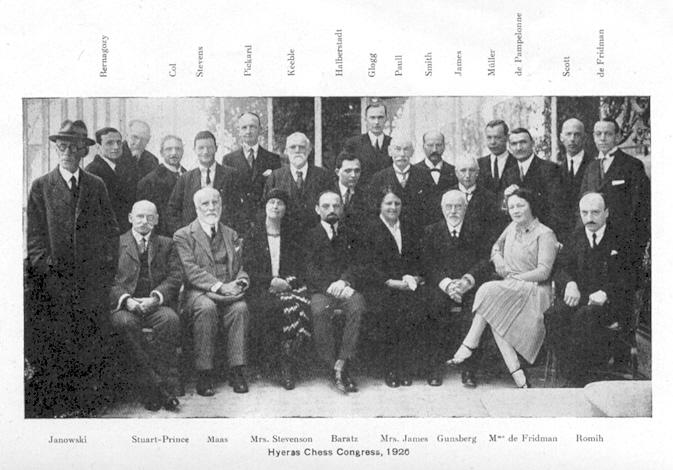
(4023)
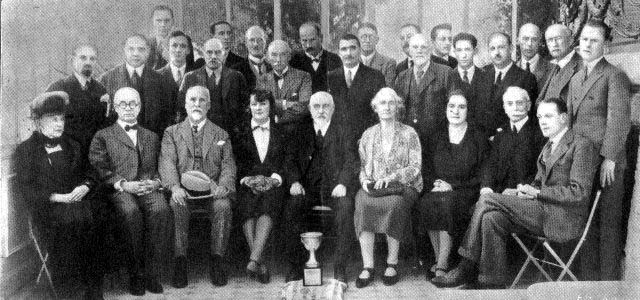
This photograph, taken at the Hyères, 1927 tournament, appeared in the March 1927 issue of L’Echiquier. The magazine gave the names as follows:
Seated (left to right): ‘Mrs Conybeare, Dr Telling, M. A.J. Maas, Mme de Fridman, I. Gunsberg, Mrs Holloway, Miss Maas, Cte J. de Villeneuve Esclapon, N. de Fridman.’
Standing: ‘MM. A. Baratz, L. Szwarzman, E. Glogg, B. Reilly, Stuart-Prince, H. Grob, S.J. Holloway, X, Dr E.H. Smith, R. de Pampelonne, Dr Rutherford, M. Paull, J. Keeble, Daschmann, W. Orbach, J. de Sandal-Roy, R.H.V. Scott, G.K. Nuttall, E. Beltikhine.’
(3606)
Luca D’Ambrosio (Bolzano, Italy) submits a key to the Meran, 1924 group photograph, based on information in L’Italia Scacchistica, 6 April 1924, page 3, and Het Schaakleven, 15 March 1924, page 125. The names in brackets below were given only by the latter publication.
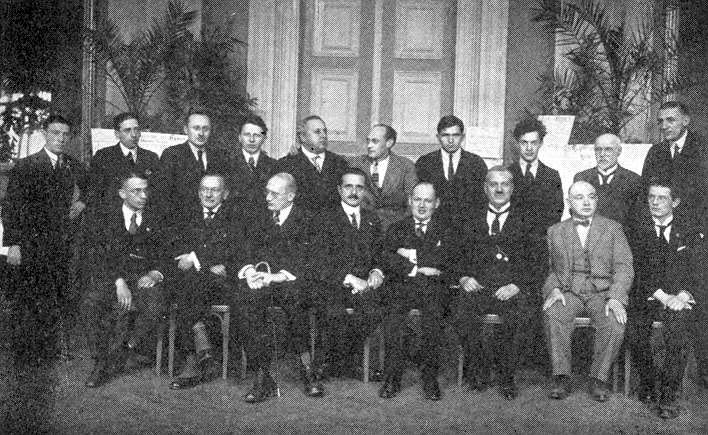
Standing, from left to right:
(Balaban), E. Colle, A. Selesniev, K. Opočenský, G. Patay, S.
Takács, L. Steiner [not E. Steiner – see C.N. 4808], G.
Koltanowski, I. Gunsberg, (Michel).
Seated: J.A. Seitz, S. Tarrasch, E. Grünfeld, S.
Rosselli del Turco, R. Spielmann, L. Miliani, D. Przepiórka,
(Grim).
(4669)
Michael McDowell (Westcliff-on-sea, England) quotes an item from the ‘Our Members’ column on pages 59-60 of The Problemist, January 1937:
‘Mr S.G. Luckcock began to play chess at the age of 21 and in a year or two won the “Championship” of a local chess club. He is now the present holder of the “Chess Amateur” Correspondence Championship for North London, which he won in April 1929, and the London and Middlesex Group C.C. since July 1935.
He took up correspondence play because his business did not give him time to belong to a Club, even locally.
He is a quick solver and very rarely sets up a position, but likes solving from the printed diagrams.
Here is one of his interesting reminiscences:
“I was playing with several others against Mr Blackburne in simultaneous chess one evening. We had our score sheets by our side, when a gentleman tapped me on the shoulder saying he would like a word. He asked me if I was S.G. Luckcock, the problemist. I said that no-one had called me that until now but that I had published a few. He said, ‘I am glad to know you for I am the Chess Editor you submit them to’, and it was I. Gunsberg speaking. He introduced me to his son Alfred, a lad about my own age, who afterwards married my eldest sister: through this connection I met Mason, Dr Lasker, Lee, Marshall, Pillsbury, Teichmann and many others famous in those days and at the Divan Café played singly against Gunsberg and Marshall, losing both my games, of course, but this gave me a great enthusiasm for the game and, as I got to play better, I lost my power to compose problems.”’
(5277)
The second fascicule of Les échecs modernes by Henri Delaire, publication of which was announced on pages 167-168 of the June 1915 issue of his magazine, La Stratégie, has a number of scarce photographs, although they are under 2.5cm in width. One example:
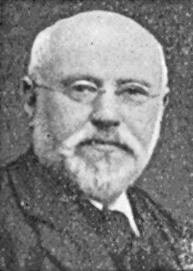
Isidor Gunsberg
(7429)
Relatively early occurrences of the term ‘grandmaster’ continue to be welcomed. The following, submitted by John Blackstone (Las Vegas, NV, USA), was written by Gunsberg on page 6 of The World, 16 January 1891:
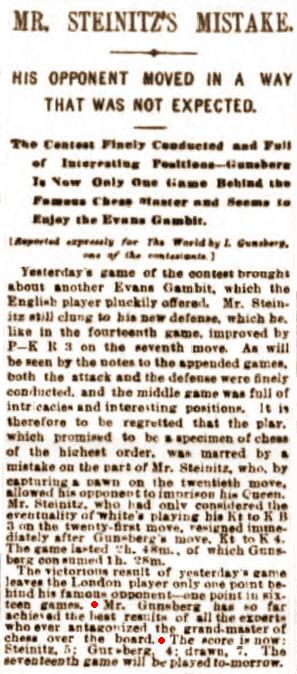
(7779)
Many issues of W.H. Watts’ magazine the Chess Budget in 1925-26 had this full-page advertisement on the back cover:
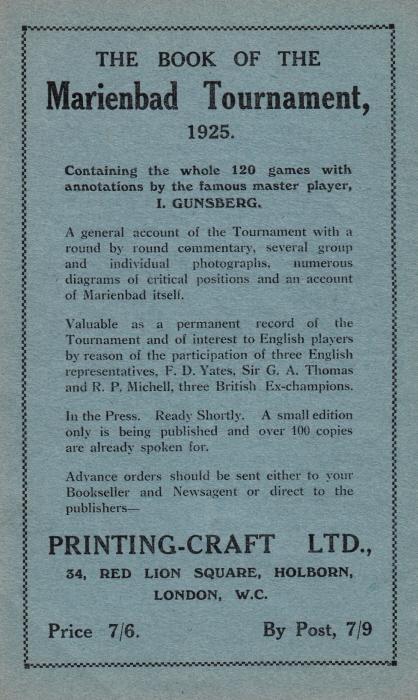
There was also a notice on page 378 of the September 1925 BCM, but the book by Gunsberg appears to exist only in the German edition mentioned in C.N. 8815:
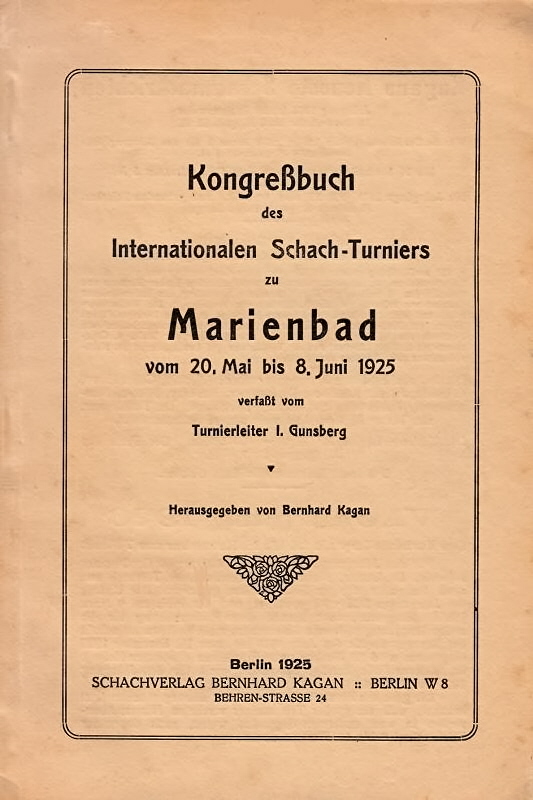
(8821)
Jan Kalendovský (Brno, Czech Republic) has been trying to identify all the figures in the group photograph of Marienbad, 1925:
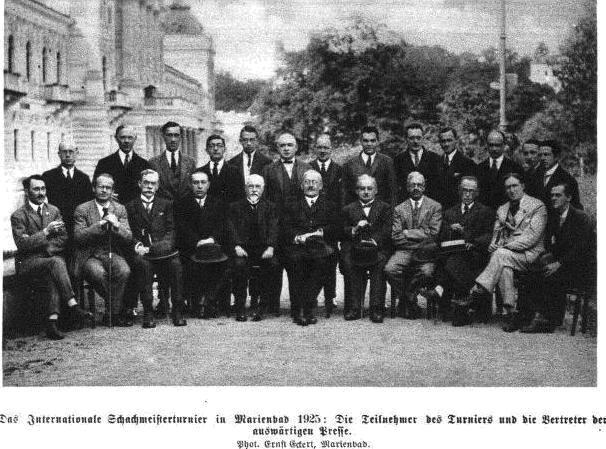
He offers the following:
‘Seated (left to right): N.N., A. Nimzowitsch, R.P. Michell, A. Rubinstein, I. Gunsberg, N.N., V. Tietz, Sir George Thomas, D. Janowsky, F.J. Marshall, F.D. Yates
Standing: L. Burian, H. Kmoch(?), M. Walter, C. Torre, N.N., D. Przepiórka, R. Spielmann, R. Réti, E. Grünfeld, F. Sämisch, S. Tartakower, A. Haida, K. Opočenský.’
The photograph appeared at the start of the tournament book, with the caption ‘Tournament participants and guests’ (‘Teilnehmer und Gäste des Turniers’). Mr Kalendovský reports that it was originally published in the Wiener Bilder, 7 June 1925.
(5119)
Alan McGowan (Waterloo, Canada) mentions that a key to the Marienbad, 1925 group photograph was published on page 89 of the May-June 1925 American Chess Bulletin. The additional information it supplies is:
(5125)
Olimpiu G. Urcan (Singapore) has sent us two photographs, taken in early 1894, of H.E. Bird, I. Gunsberg and J.H. Blackburne:
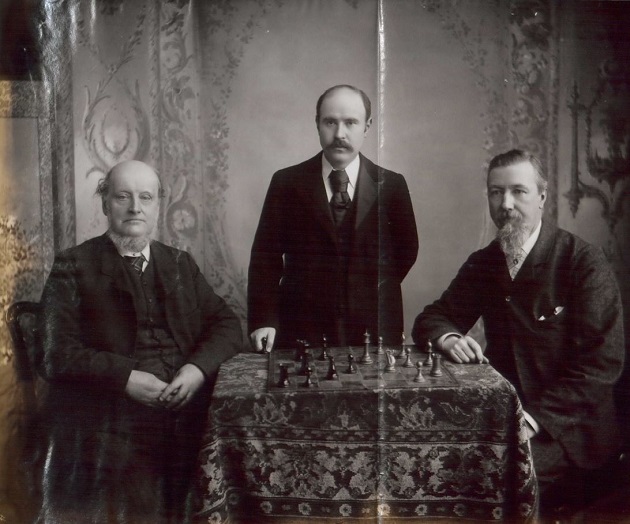
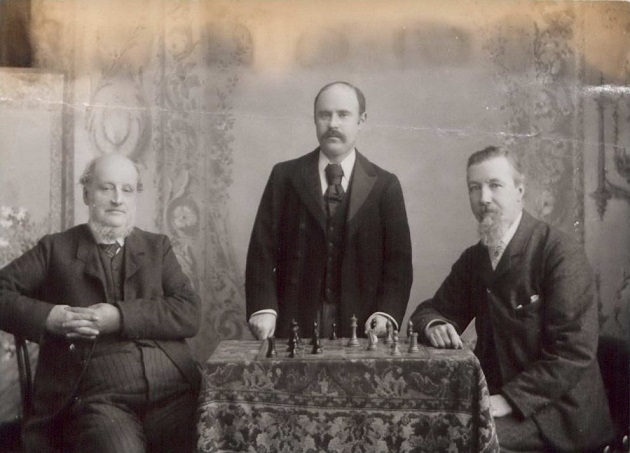
Our correspondent’s source is as specified in C.N. 9296, where forgotten portraits of Lasker and Blackburne were presented. The first shot of Bird, Gunsberg and Blackburne above was included, from a different source, on page 132 of Tim Harding’s fine book Eminent Victorian Chess Players (Jefferson, 2012).
(9527)
C.N. 10018 mentioned that an uncreased copy of the first photograph was published on page viii of Hastings 1895 by Colin Crouch and Kean Haines (Sheffield, 1995).
Page 291 of the Chess Player’s Chronicle, 16 December 1891 provides this addition to Fast Chess:
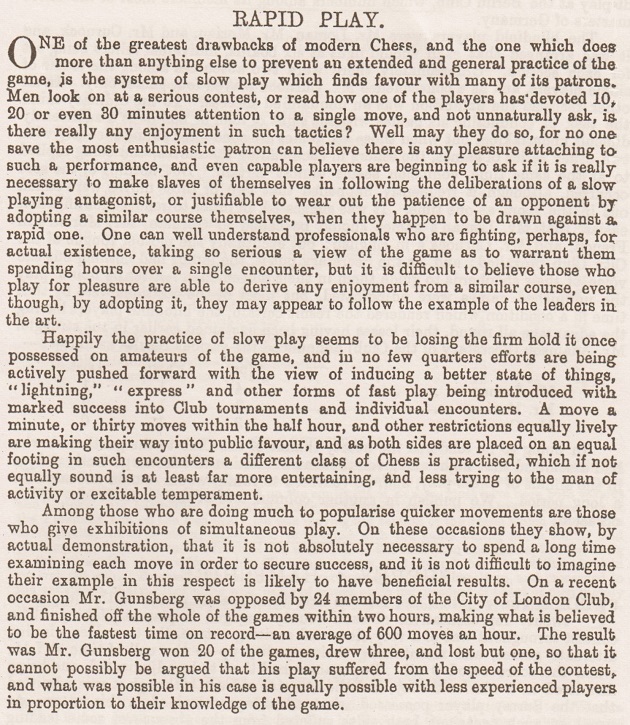
(11798)
Concerning the legal cases Gunsberg v Volksblatt and Lee v Gunsberg (1890), as well as Gunsberg v Foster (1916), see Chess in the Courts. Below is the opening section of our coverage of the Gunsberg-Foster case:
In his chess column on page 4 of the (London) Daily Telegraph of 26 June 1915 Gunsberg wrote:
‘The Hostile Series. Neither Huxley nor Todhunter, though they have learnedly dealt with the average run of chances, have done sufficient justice to the problem of the hostile series. The subject is worthy of the attention of mathematicians and philosophers. Instinct is very often a more unfailing guide than the mathematician or philosopher can be. The bridge player, or any other player for the matter of that, who ceases to play when he thinks the hostile series is approaching does the right thing. At the moment we have the feeling that we are the victim of a hostile series affecting our problems. Why it should be that for many months we may not have an unsound problem, and that all at once a series of second solutions should crop up, we cannot explain, except on grounds of a regular occurrence of hostile series.’
A week later, on page 4 of the Evening News of 3 July 1915, the chess column (‘by the Chess News Agency’) included the following paragraph until the heading ‘The Hostile Series’:
‘A wonderful excuse for making blunders has been evolved by one sapient scribe of the chess world. Apparently he has been publishing more unsound problems than usual, as nearly every problem which has appeared in his column for some time has had at least two solutions; and he moralises thus: “At the moment we have the feeling that we are the victims of a hostile series affecting our problems. Why it should be that all at once a series of second solutions should crop up we cannot explain.”’
The author of those words was A.W. Foster, and Gunsberg sued for libel.
Addition on 15 April 2021:
Wijnand Engelkes (Zeist, the Netherlands) points out the existence of a small booklet by Sthig Jonasson entitled Julhälsning 1980 Jubileumsutgåva Isidor Gunsberg 1854-1930, a copy of which is in the Royal Library in The Hague. A brief summary:
In Swedish; 19 pages. 1½-page biography; 1½-page table of results; seven games: Gunsberg (as Mephisto) v N.N.; Tarrasch v Gunsberg, Hamburg, 1885; Blackburne v Gunsberg, Frankfurt am Main, 1887; Gunsberg v Mackenzie, Bradford, 1888; Mason v Gunsberg, New York, 1889; Gunsberg v Chigorin, Havana, 1890; Steinitz v Gunsberg, New York, 1890 (fifth match-game).

An addition from John Townsend (Wokingham, England) on 26 September 2022:
‘Your feature article refers to Gunsberg’s loss of a child which was noted on page 128 of the April 1890 BCM. Accordingly, the index of the General Register Office contains an entry for the death of Ernest Gunsberg, aged one, during the first quarter of 1890 in the district of Edmonton (vol. 3a, page 193). In fact, that was not Gunsberg’s only “severe domestic affliction” during that spring, since the death occurred on 8 April of his wife’s brother, David Asher Isaacs. The National Probate Calendar describes Isaacs as a schoolmaster and teacher, who died at 123 Sandringham Road, Dalston, Middlesex. The will was proved on 7 July by “Isidor Gunsberg, of 38 Walford Road, Stoke Newington, Middlesex, chess player and journalist, one of the executors”. The personal estate amounted to £260.
The age of Isaacs was given by the General Register Office as 40. Some biographical details about him are to be found on page 453 of The Palgrave Dictionary of Anglo-Jewish History, edited by William D. Rubinstein, Michael A. Jolles and Hilary L. Rubinstein, 2011. Briefly, he was born in Aldgate, London, son of a Dutch-born rag merchant; in 1871 he graduated with a First from the University of London and, after obtaining a teaching certificate, held several teaching posts, including Headmaster of the West Metropolitan Jewish School in Red Lion Square.
It may be inferred that he was a close associate of Gunsberg’s family from the circumstance of the Gunsberg’s appointment as an executor. As noted in your article, in the following year, 1891, Gunsberg also lost his wife, Jane, the sister of Isaacs.’
See also The Chess Masters of To-day by Leopold Hoffer.
To the Chess Notes main page.
To the Archives for other feature articles.
Copyright: Edward Winter. All rights reserved.